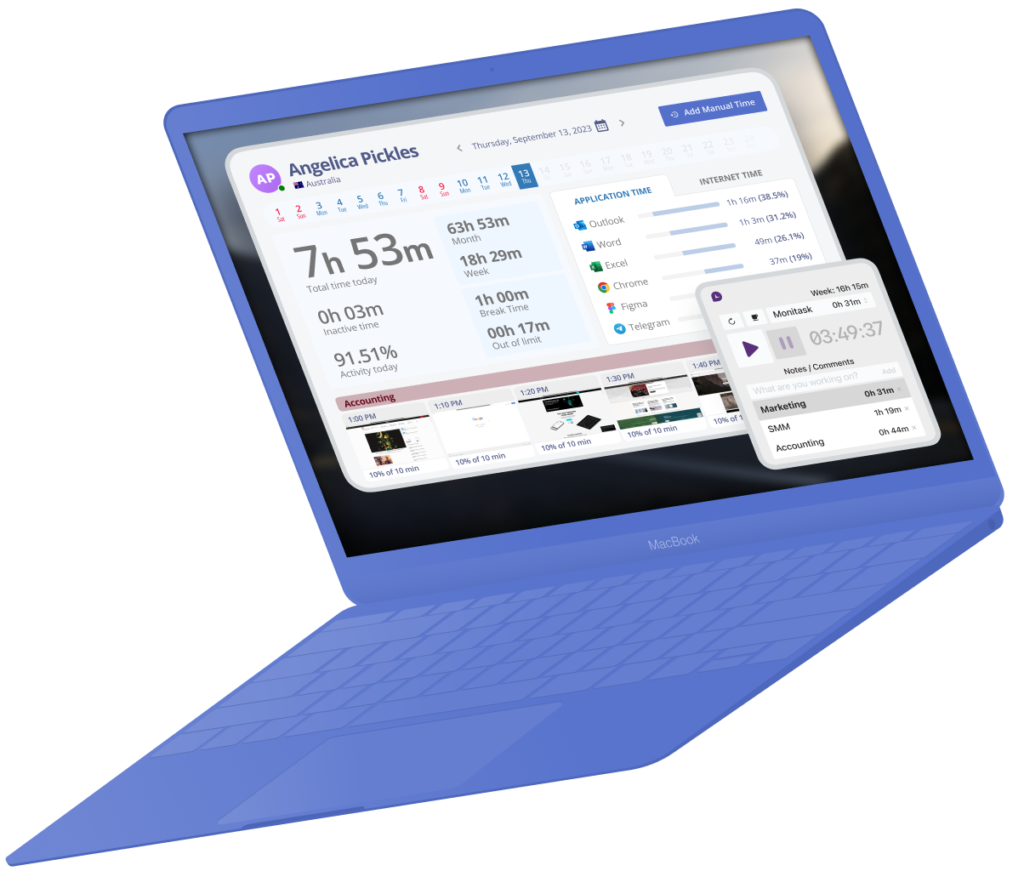Remote work monitoring is becoming an increasingly essential aspect of modern project management. With more and more companies embracing remote work after the COVID-19 pandemic, it’s important to have employee monitoring tools that can help track the productivity metrics of the remote workforce.
By using a time tracking tool, employers can gain valuable insights into how their remote employees are spending their time, which tasks are taking longer than expected, and which employees may need additional support to stay on track. Ultimately, employee tracking can help companies maximize worker productivity and ensure that task management is done efficiently and effectively.
Remote work tracking is the practice of using a specialized employee tracking tool to monitor and measure employees’ performance. It usually includes task management, accurate time tracking, productivity tracking, and reporting capabilities that help employers track time spent on project management and which tasks are being completed.
This information can be used to assign tasks and make ensure employees are on track, making it easier for managers to offer additional support when needed. Additionally, remote work monitoring also helps employers to identify areas in project management where efficiency could be improved to optimize results.
Companies with remote employees work hard to establish a culture of trust and engagement. Yet, implementing employee monitoring can be challenging as it can potentially harm the remote work environment if not done correctly. Some practices can be followed to ensure that remote employee monitoring is done effectively without negatively impacting morale or employee engagement.
There should be an open dialogue between the employer and remote employees about how exactly productivity tracking will work. This means being clear about what data is being collected, who will access it, and how long it will be stored. Employers must obtain informed consent from remote employees before implementing any monitoring measures.
The remote workforce should have a clear understanding of what they are agreeing to and the impact it may have on their privacy. As well, employers need to strike a balance between monitoring employee productivity and ensuring the privacy and autonomy of their employees.
Remote work tracking should be used to provide visibility into how employees are working, not to micromanage their every move. Employers need to remember that remote employee monitoring software should be used to respect the autonomy of employees and help them work more efficiently.
Support autonomy by providing the remote workforce with tools, resources, and feedback while respecting their privacy and personal space. Employers can also foster a culture of autonomy by setting clear expectations, goals, and deadlines, and empowering employees to solve problems on their own. This can improve job satisfaction, reduce turnover, and boost team performance.
When monitoring employees, it is important to establish clear guidelines and expectations. This includes establishing specific work hours, outlining communication protocols, and setting productivity goals. It is also important to trust employees and avoid micromanaging.
Regular check-ins ensures that work is progressing smoothly and addressing any concerns or issues. Additionally, it is important to provide employees with the necessary tools and resources to effectively work from home. By following these guidelines, employers can effectively monitor remote workers while also promoting a positive and productive work environment.
Monitoring remote work should be an ongoing process that takes into account the feedback of employees. Employers need to be open to adapting the remote work monitoring process and make changes when needed. This helps ensure that productivity tracking is both effective and efficient.
It is important to create a system for employees to give feedback on the monitoring process. This can be done by conducting surveys, focus groups, or one-on-one interviews. Allowing employees to offer their opinions can help employers gain valuable insights into task management and make the necessary changes for successful productivity tracking.
Employee monitoring software can track employee activity and identify areas for improvement helping employers to increase task management efficiency
Monitoring software can protect sensitive data, reducing the risk of data breaches and cyberattacks.
Employee monitoring software can help identify areas of waste, allowing employers to make informed decisions on project management
Time tracking tools can help ensure legal compliance with regulations such as HIPAA, and GDPR, reducing the risk of legal liability and penalties.

Remote work tracking is an invaluable tool for project management and gaining insight into how remote workers are meeting their goals and objectives. However, it is important to implement a time tracking tool in an ethical way that respects employee autonomy and privacy.
Done correctly, employee monitoring software can help optimize performance and reduce waste, while also helping employers create a culture of trust and engagement. Employers need to ensure that tracking software operates with transparency and honesty, while also providing the necessary support and resources for employees working to succeed in their roles.
It’s a tool used by employers for time tracking of remote employees. It allows employers to monitor employee productivity, track attendance, and record time spent on specific tasks. The employee monitoring software can also capture screenshots, improve project management, and monitor internet usage.
Employers are legally allowed to monitor their employees’ computer activity as long as they provide notice. Check your employee handbook or ask HR if they have a monitoring policy in place. Signs of tracking software monitoring can include slow computer performance, restricted access to certain websites, and pop-up warnings.
Use a time-tracking tool or app. Input your task or project and starts the timer when you begin working. Stop the timer when you finish. You can review the timesheet to check you have clocked in the correct number of hours.